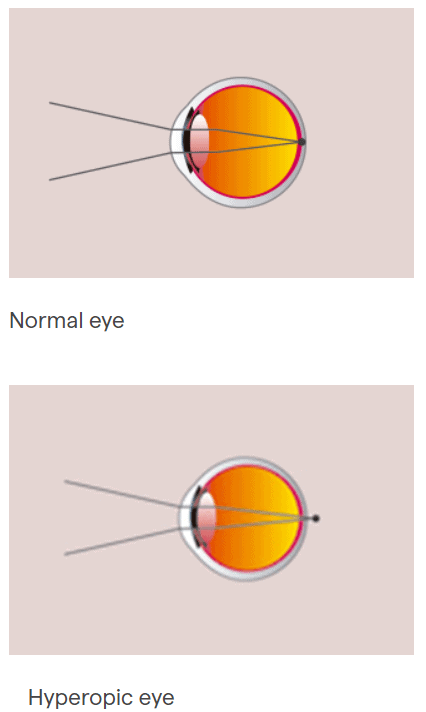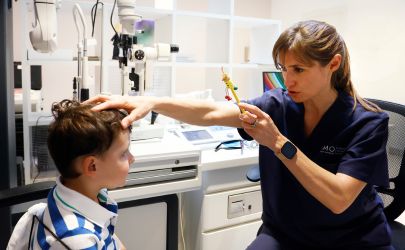What is hyperopia?

- Also known as farsightedness, it is a refractive defect or error in visual focusing
- Images are focused behind the retina
- Vision becomes blurred, especially up close.
What causes it?
Most babies are hyperopic at birth (physiological type), a defect that is corrected as the eye develops, and usually disappears during adolescence. If it is not fully corrected by this age, it is likely that it will persist for life, but will stabilise.
If farsightedness has not been completely corrected by adolescence, it is likely to persist for life. Although hyperopia does not usually evolve.
How can it be prevented?

- In most cases, it is an inherited refractive defect
- Occasionally, a comprehensive eye examination is the only way to diagnose hyperopia.
- It cannot be prevented but regular eye examinations, especially in childhood, help to detect it in its early stages.
- It is caused by the diameter of the eyeball being smaller than normal or the cornea being too flat.
It is advisable for people who have been diagnosed with hyperopia to have their eyes checked once a year because farsightedness can be associated with other diseases, such as glaucoma.
Symptoms
- The main symptom is blurred vision of nearby objects.
- Most patients with hyperopia, however, are usually asymptomatic in their youth, as they are able to compensate for poor near vision through the accommodative ability of the crystalline lens (the eye’s natural lens whose elasticity enables objects to be focused on). The crystalline lens’s elasticity is lost with age.
Constant movement of the eye’s muscles in young patients can cause symptoms that are not directly related to vision, such as:
- headaches
- fatigue
- pain
- redness of the eye
Special attention to the little ones

Gestures such as rubbing the eyes or wrinkling the forehead on a regular basis may be the first signs of hyperopia.
For that reason, it is important that children have regular eye tests.
In the case of children, parents should be particularly attentive to certain symptoms, some of which are not usually associated with vision, such as underachievement at school or the inability to adapt.
If hyperopia in children remains untreated it can cause:
- strabismus (deviation of the eyes)
- amblyopia (also known as lazy eye)
Treatments
La hipermetropía puede corregirse fácilmente con gafas (con lentes convergentes) o con lentes de contacto.
Aunque el grado de hipermetropía sea pequeño, la corrección es aconsejable para evitar problemas secundarios, como dolores de cabeza o irritación ocular.
Tratamiento quirúrgico
- Si el hipermétrope quiere prescindir de corrección óptica, puede beneficiarse de algunas técnicas de cirugía refractiva indicadas para personas con un grado de hipermetropía bajo.
- Otra opción son las lentes intraoculares fáquicas (entre la córnea y el cristalino), indicadas para pacientes con defectos más altos.
- Para hipermétropes de más de 40-45 años, las lentes pseudofáquicas (que sustituyen al cristalino) pueden ser también una solución. Es el misma cirugía que se utiliza en la cirugía de cataratas.
La cirugía refractiva para la corrección de la hipermetropía es especialmente delicada y requiere una evaluación previa completa para la selección apropiada de su tratamiento.
FAQs
For the first two weeks, in particular, the patient should avoid rubbing the eyes, going swimming in a public pool and using eyelid make-up.
The patient can generally have acceptable or near-maximum vision within a few hours. Occasionally, however, it can take up to a week for vision to improve.
Yes, as can all post-operative patients, irrespective of the pathology, provided that their physical condition permits and several days have passed since the operation.
Nowadays, there are several techniques. The most popular for small refractive errors, such as myopia, hyperopia and astigmatism, is LASIK. In special cases there are other options available: phakic lenses, crystalline extraction, intracorneal lenses or intrastromal rings.
IMO Institute of Ocular Microsurgery
Josep María Lladó, 3
08035 Barcelona
Phone: (+34) 934 000 700
E-mail: international@imo.es
See map on Google Maps
By car
GPS navigator coordinates:
41º 24’ 38” N – 02º 07’ 29” E
Exit 7 of the Ronda de Dalt (mountain side). The clinic has a car park with more than 200 parking spaces.
By bus
Autobus H2: Rotonda de Bellesguard, parada 1540
Autobus 196: Josep Maria Lladó-Bellesguard, parada 3191
Autobuses H2, 123, 196: Ronda de Dalt – Bellesguard, parada 0071
How to arrive at IMO from:
IMO Madrid
C/ Valle de Pinares Llanos, 3
28035 Madrid
Phone: (+34) 910 783 783
See map in Google Maps
Public transport
Metro Lacoma (líne 7)
Autobuses:
- Lines 49 & 64, stop “Senda del Infante”
- Line N21, stop “Metro Lacoma”
Timetables
Patient care:
Monday to Friday, 8 a.m. to 8 p.m.
IMO Andorra
Av. de les Nacions Unides, 17
AD700 Escaldes-Engordany, Andorra
Phone: (+376) 688 55 44
See map in Google Maps
IMO Manresa
C/ Carrasco i Formiguera, 33 (Baixos)
08242 – Manresa
Tel: (+34) 938 749 160
See map in Google Maps
Public transport
FGC. Line R5 & R50 direction Manresa. Station/Stop: Baixador de Manresa
Timetables
Monday to Friday, 08:30 A.M – 13:30 PM / 15:00 PM – 20:00 PM





